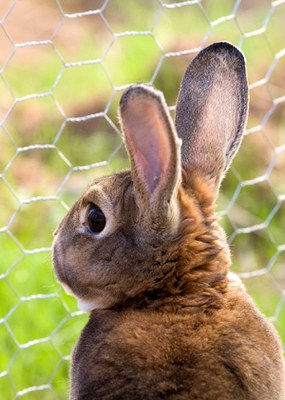Hungry Hares
The plants in our gardens are finally growing—and rabbits are hopping for joy.
Rabbit populations are soaring. They have multiple litters during the year, and it is common for a rabbit couple to have 20 or more offspring each year. When you realize each rabbit can eat one-half pound of vegetation a day, a family of rabbits can quickly destroy a garden.
The most effective strategy to stopping rabbits is to put a fence between them and the garden.
Chicken-wire fencing is recommended. The fence needs to be at least 24 inches tall for cottontails and 36 inches for jackrabbits. Bury the fence 6 inches deep. Bend the bottom edge of the fence at a 90-degree angle pointed outwards to discourage digging. The mesh must be 1.0 inch or less.
Repellents have been tried by gardeners for generations, but none are totally reliable. Marigolds, dried blood, moth balls, hot pepper, and ammonium or potassium salts of soaps may not stop a hungry rabbit. Many repellents cannot be applied directly onto the vegetables. Read and follow all instructions on the label carefully.
Scare devices including scarecrows, plastic owls, jars of water, and motion-activated sprinklers have limited use because the rabbits get used to them quickly. A guard dog near the garden can be an effective repellent.
Live trapping usually does not work as jackrabbits are reluctant to enter a cage. Cottontails are more easily trapped and can be coaxed into a cage with baits of apple, carrot, or cabbage. Trapping is best done in winter and early spring when natural food sources are scarce.
Shooting is another option, but there may be local restrictions.
Written by Tom Kalb, Extension Horticulturist, North Dakota State University. Photo courtesy of David O. Source: Vantassel, S.M., S.E. Hygnstrom, D.M. Ferraro and J.J. Lusk. 2010. Managing Rabbit Damage. University of Nebraska-Lincoln Extension.






